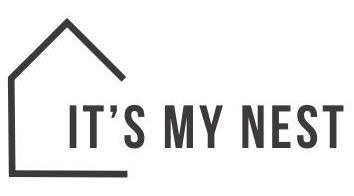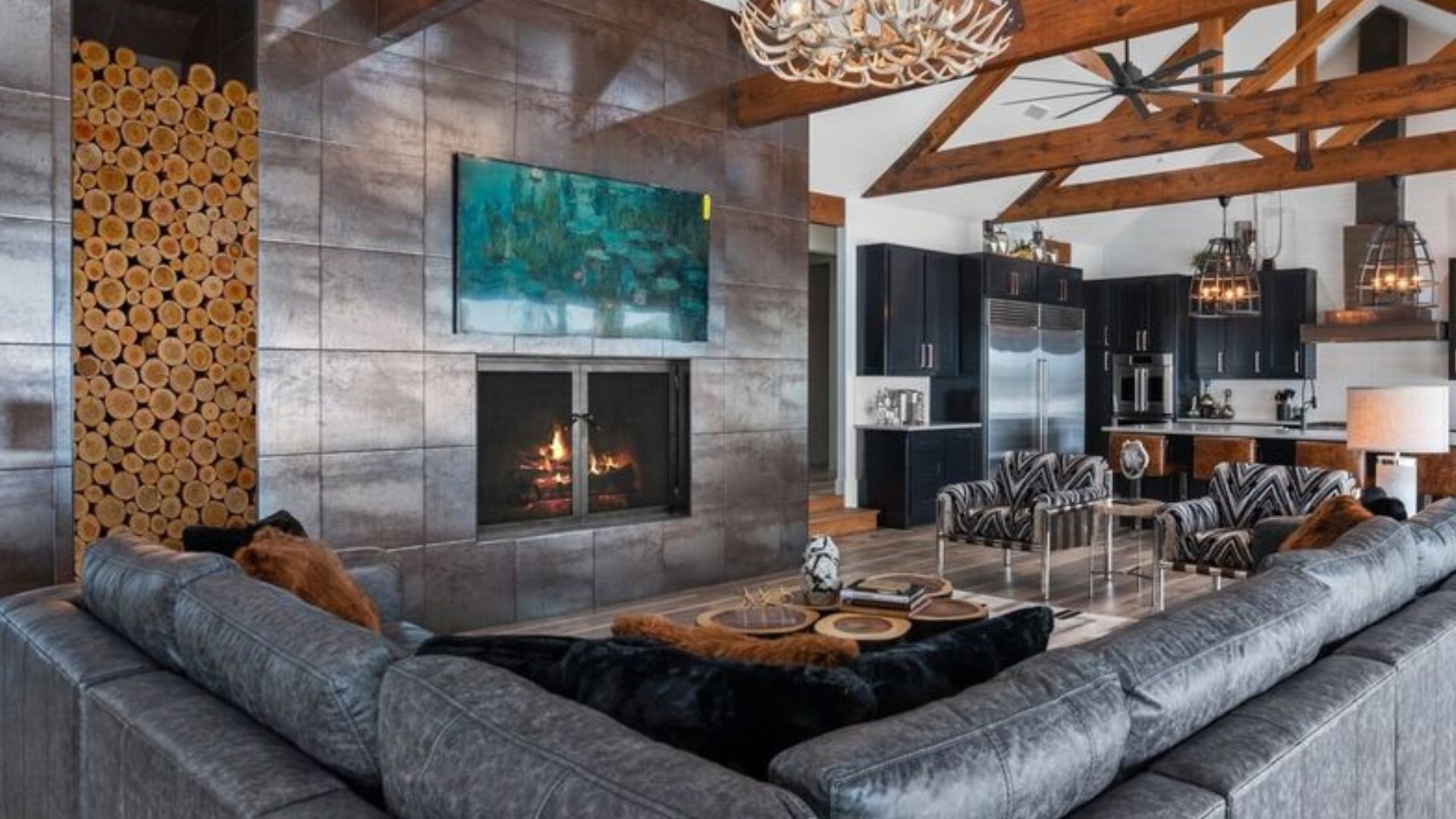Do you know what makes industrial interior design so captivating? It’s a harmonious blend of rawness and sophistication that brings an edgy yet chic vibe into any space. I’m thrilled to share with you 37 unique elements that define this style.
Each item is a testament to the charm of embracing the unfinished and the boldness of integrating the functional with the aesthetic. Let’s explore these elements together and see how they can transform your space.
1. Exposed Pipes
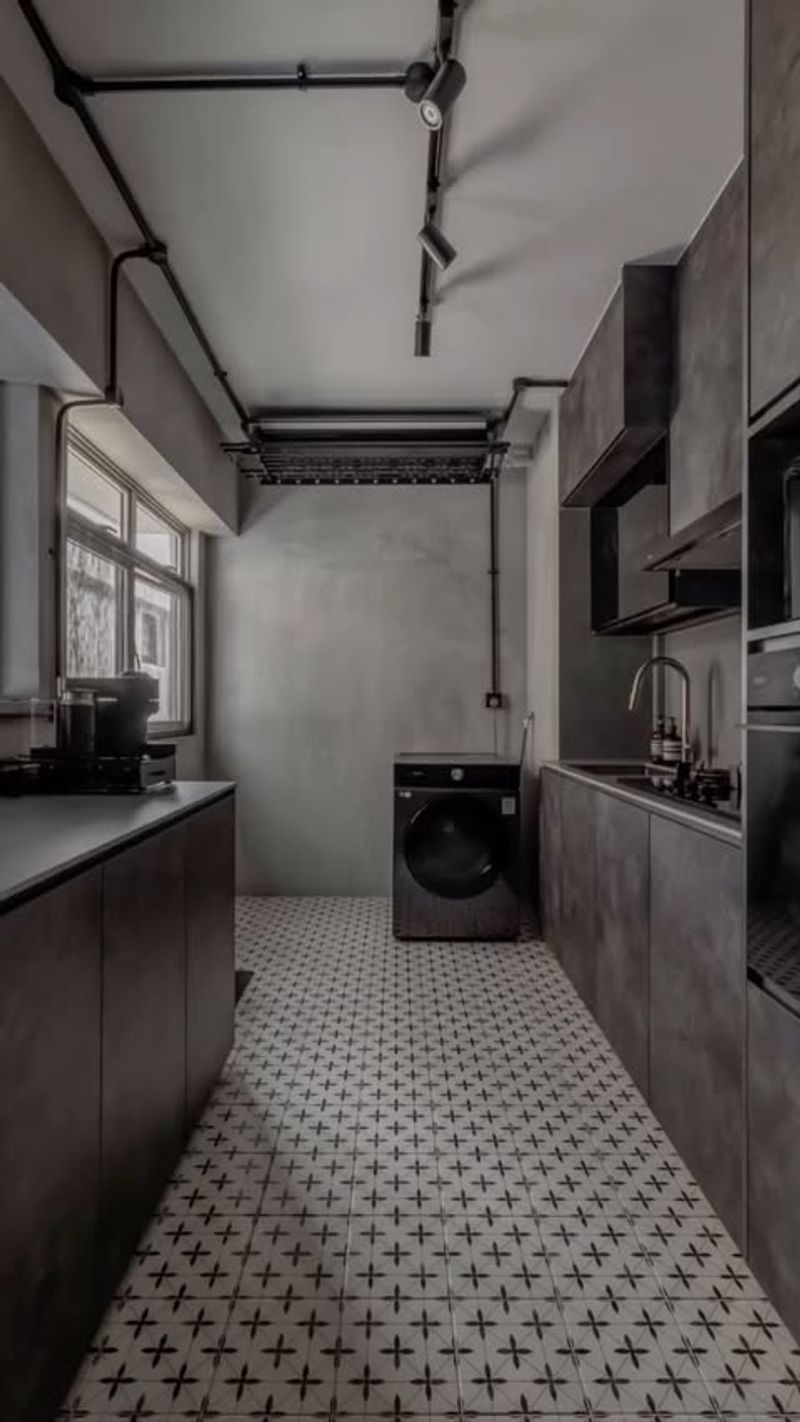
There’s something undeniably appealing about exposed pipes. It brings a sense of rawness that industrial design thrives on. Metal pipes, often left bare, can run along ceilings or even walls, adding a structural aesthetic.
Their metallic sheen offers a striking contrast against softer elements like wood or textiles. I believe these pipes tell a story of urban living, where form meets function in an unapologetically authentic way. It’s a design choice that speaks volumes without uttering a word.
2. Concrete Floors
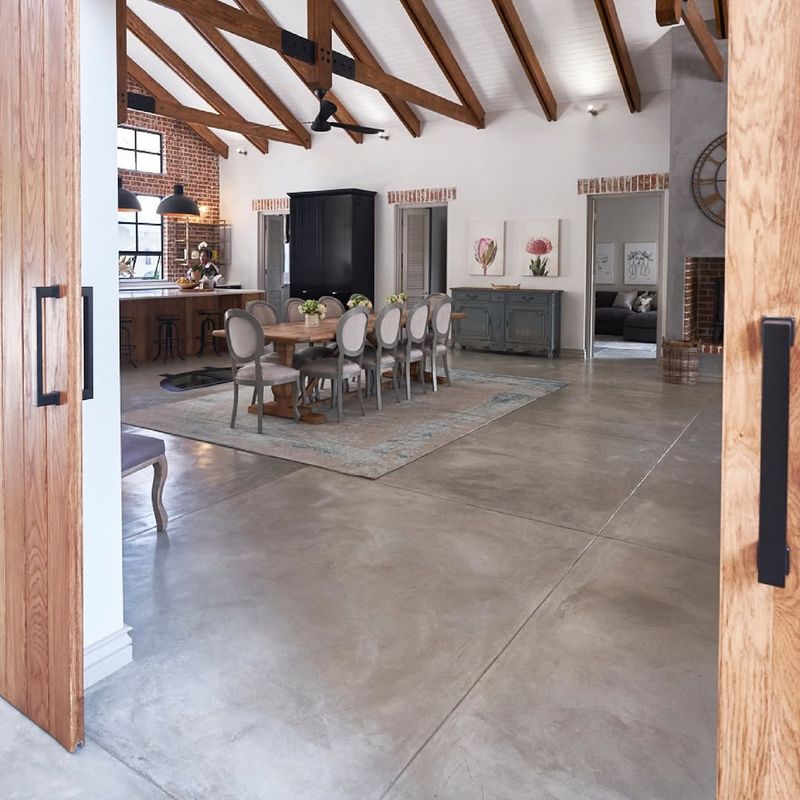
Concrete floors are the unsung heroes of industrial design. They offer a sleek, modern look with a hint of rugged charm. When polished, they reflect light beautifully, making spaces feel larger and more open.
The neutrality of concrete allows for versatility in pairing with various colors and textures. I often tell friends that these floors require minimal maintenance, and their durability is unmatched. Embracing concrete is embracing a grounded yet stylish foundation for any room.
3. Brick Walls
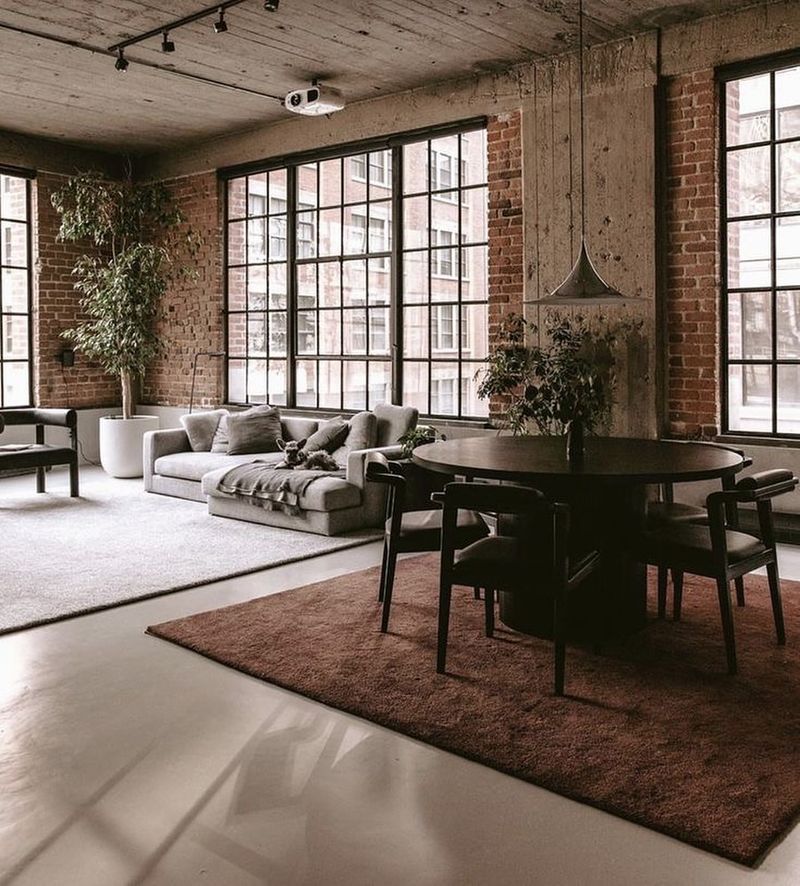
Exposed brick walls have a distinctive character that can transform any room. They exude warmth while providing a textured backdrop that enhances other design elements.
Whether painted or left in their natural state, brick walls add depth and a rustic vibe. I find them particularly inviting in living spaces, where they create a cozy yet sophisticated atmosphere. Working with brick is all about celebrating imperfection and history, making it a timeless feature.
4. Steel Beams
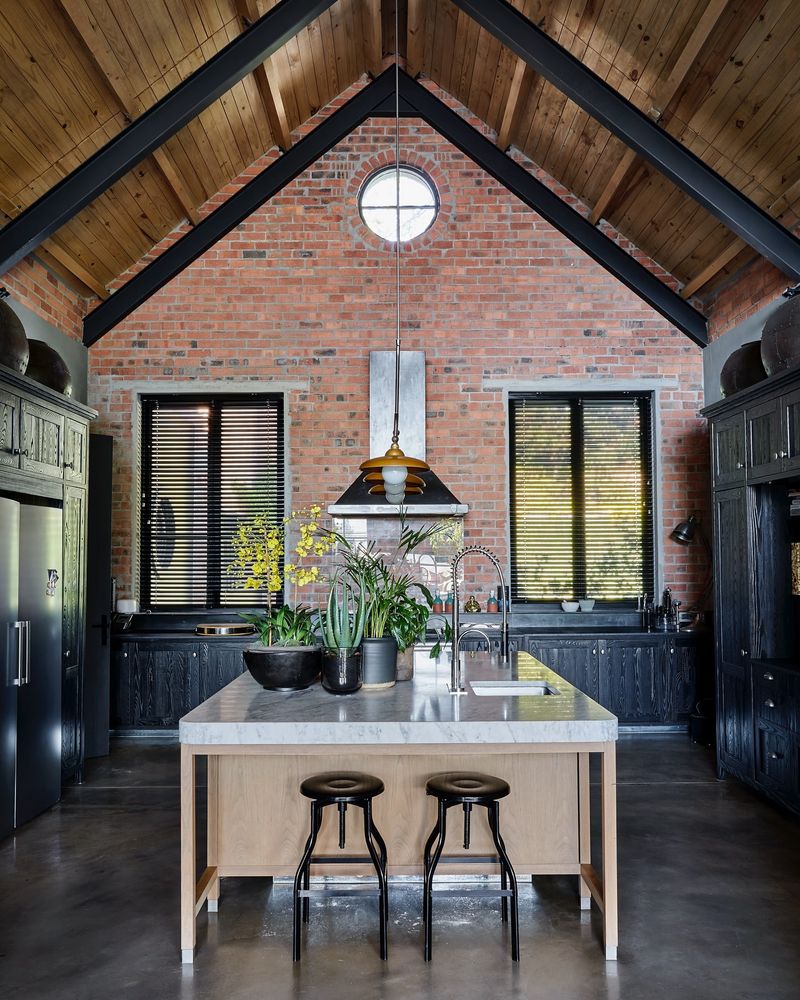
Steel beams are synonymous with industrial design, offering both structural integrity and aesthetic appeal. They introduce a bold, modern element that can redefine a space’s character.
I love how they work in harmony with open-concept designs, emphasizing the room’s height and dimension. These beams are not just functional but also a statement piece, often left exposed to showcase their raw beauty. It’s a nod to the industrial era, where strength and style go hand in hand.
5. Vintage Lighting
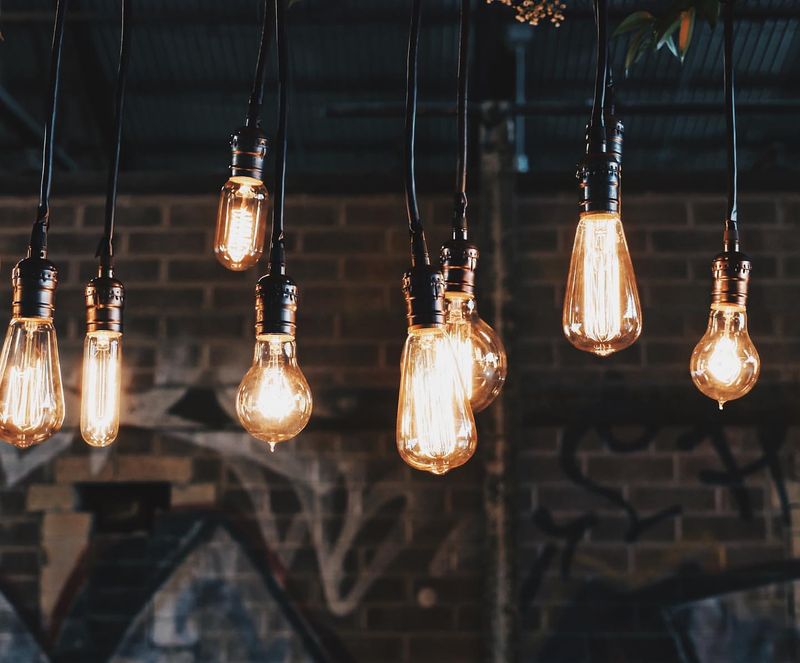
Vintage lighting is like the cherry on top of industrial design. It adds a touch of nostalgia while enhancing the overall ambiance. Edison bulbs, with their warm glow, are perfect for creating an inviting atmosphere.
I often recommend incorporating rustic chandeliers or pendant lights for a more dramatic effect. These fixtures bring in the charm of yesteryears while illuminating your space with style. It’s all about balancing the old with the new, crafting a space that’s both cozy and chic.
6. Open Spaces
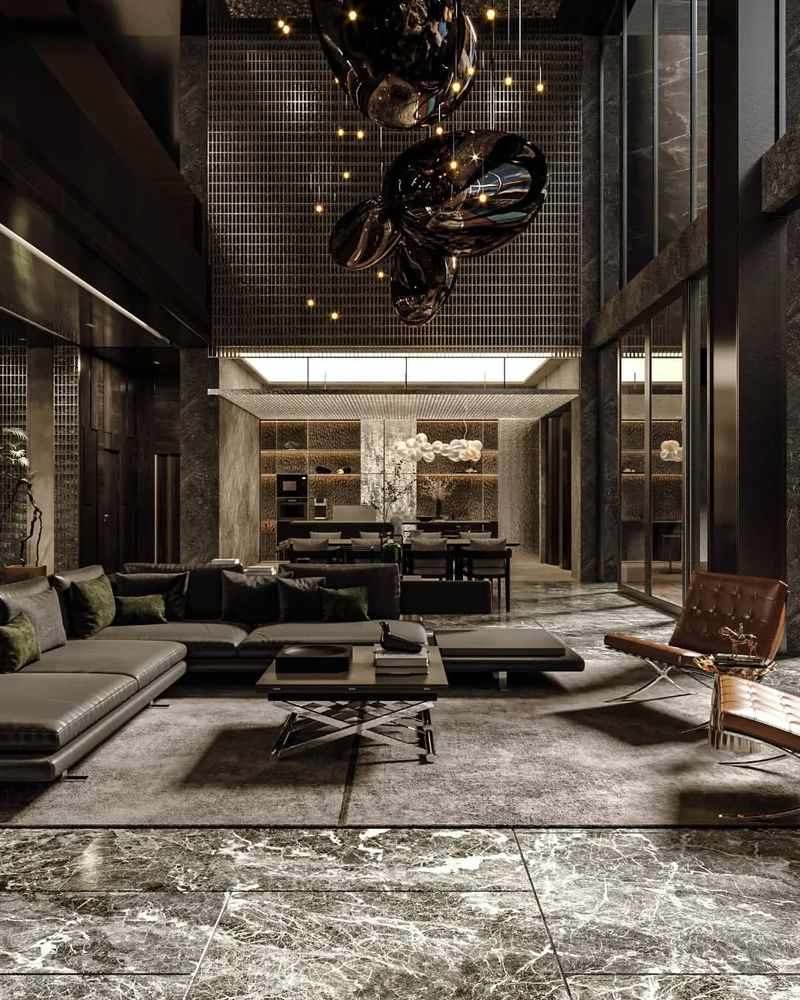
Open spaces are a staple in industrial design, fostering a sense of freedom and fluidity. By minimizing partitions, these areas encourage natural light flow and make rooms feel expansive.
I appreciate how this design element allows for creativity in layout and functionality. It’s perfect for those who enjoy an airy, uncluttered environment. Embracing open spaces is about prioritizing the essentials and letting your surroundings breathe, creating a harmonious living experience.
7. Minimalist Furniture

Minimalist furniture complements the industrial theme by focusing on simplicity and functionality. Clean lines and subtle forms allow for a seamless blend with other design elements.
I often choose pieces made of wood and metal, which align well with the industrial palette. These furniture choices emphasize utility without sacrificing aesthetics, making them ideal for a balanced interior. It’s all about achieving more with less, highlighting the beauty in simplicity and practicality.
8. Leather Sofas
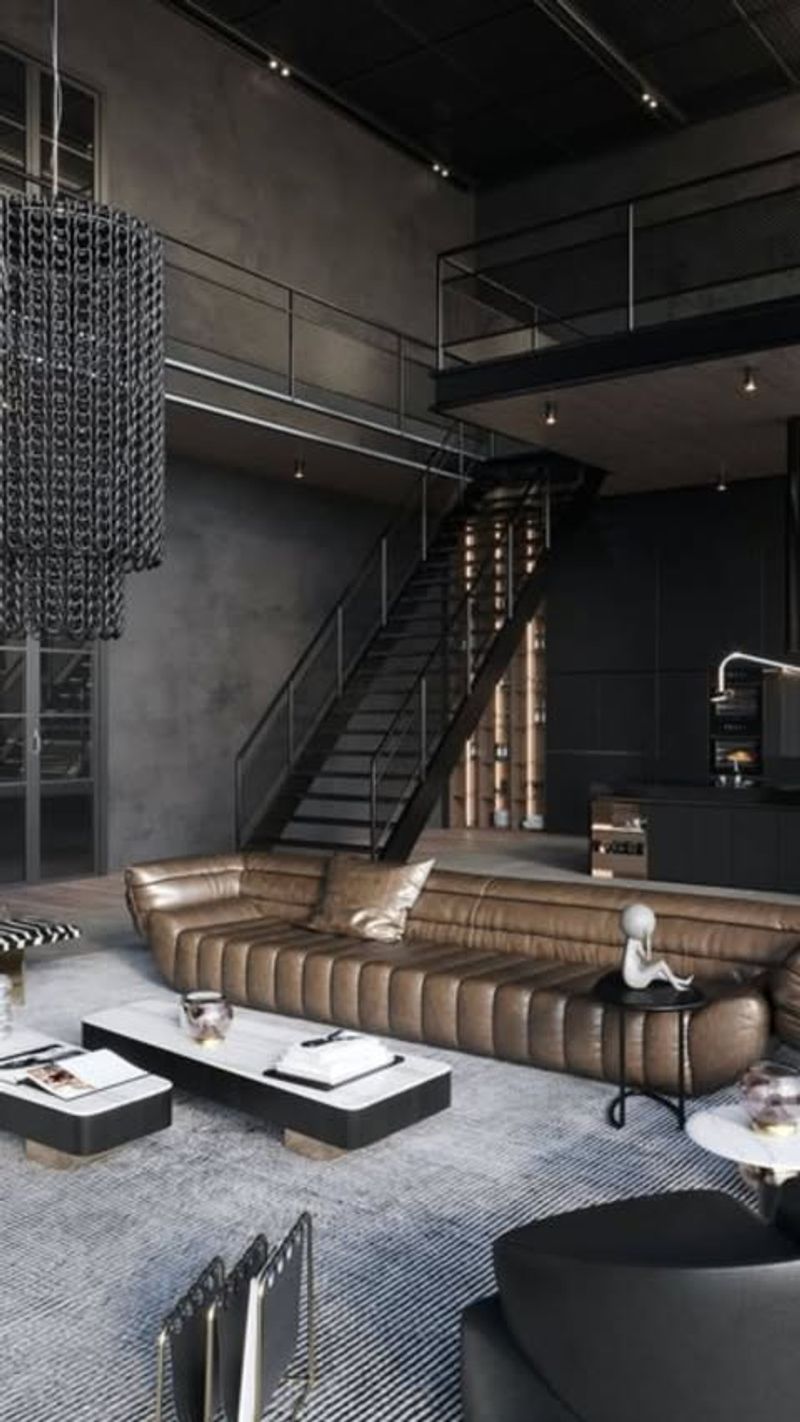
Leather sofas are a quintessential addition to industrial interiors. Their rich texture and timeless appeal add a layer of sophistication to any room. Paired with metal and wood, they harmonize beautifully with the industrial theme.
I find that leather’s natural patina only enhances its charm over time, making it both a stylish and durable choice. These sofas invite relaxation, offering comfort while serving as a bold design statement. Embrace leather for a touch of elegance and warmth in your space.
9. Glass Elements
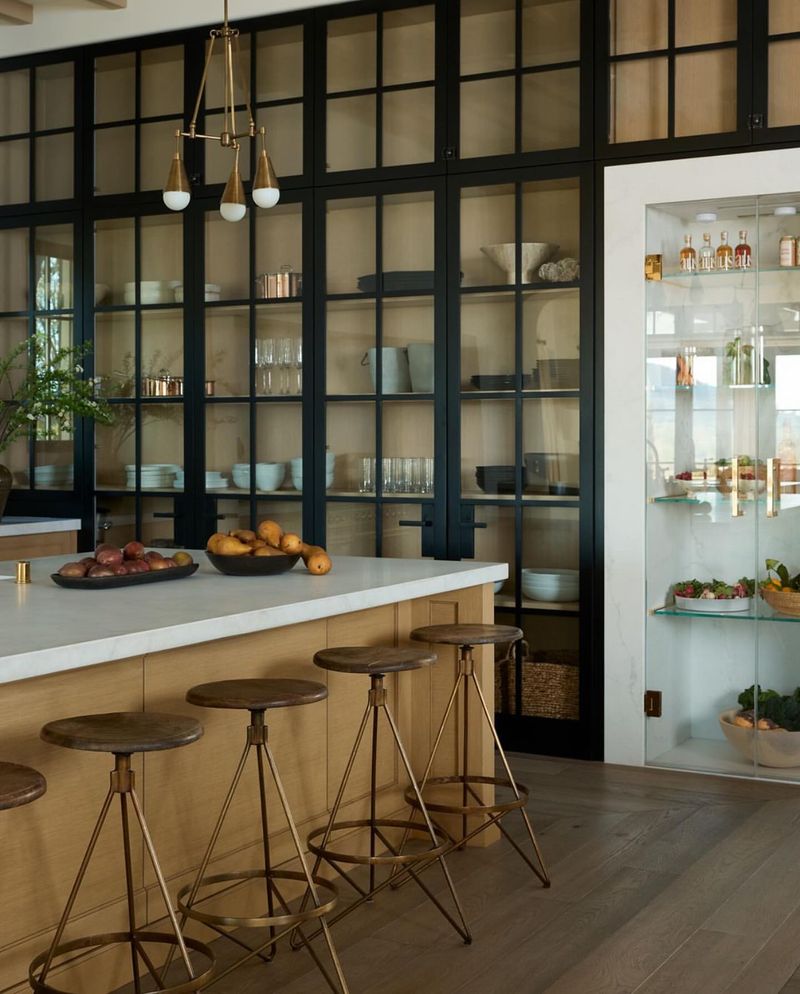
Glass elements bring a sense of transparency and lightness to industrial interiors. They beautifully contrast the heavier materials like concrete and metal. Whether it’s large windows, glass doors, or cabinetry, glass opens up spaces.
I advocate for using glass as it enhances light flow and offers an unobstructed view, making interiors feel more connected to the outside world. It’s a perfect way to soften an industrial space, adding elegance while maintaining a modern edge.
10. Wood Accents
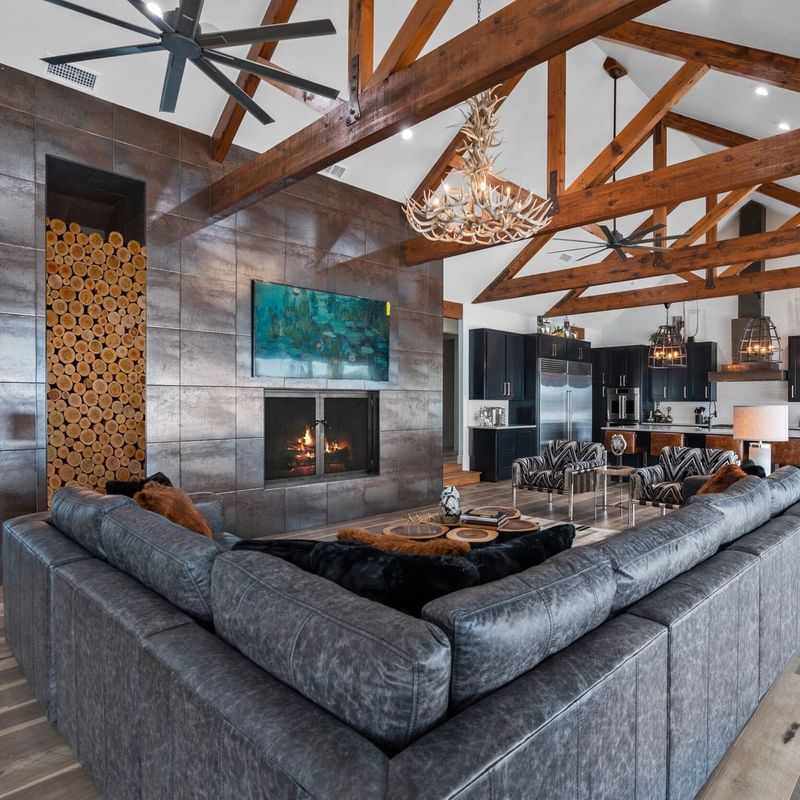
Wood accents offer warmth and texture, balancing the cool, hard surfaces typical of industrial design. Whether it’s reclaimed wood beams, tables, or shelving, these elements introduce a rustic charm.
I love how wood can act as a bridge between the old and the new, adding character and depth. It’s all about selecting pieces that showcase the wood’s natural beauty and imperfections. These accents bring life into industrial spaces, creating a welcoming and harmonious environment.
11. Industrial Artwork
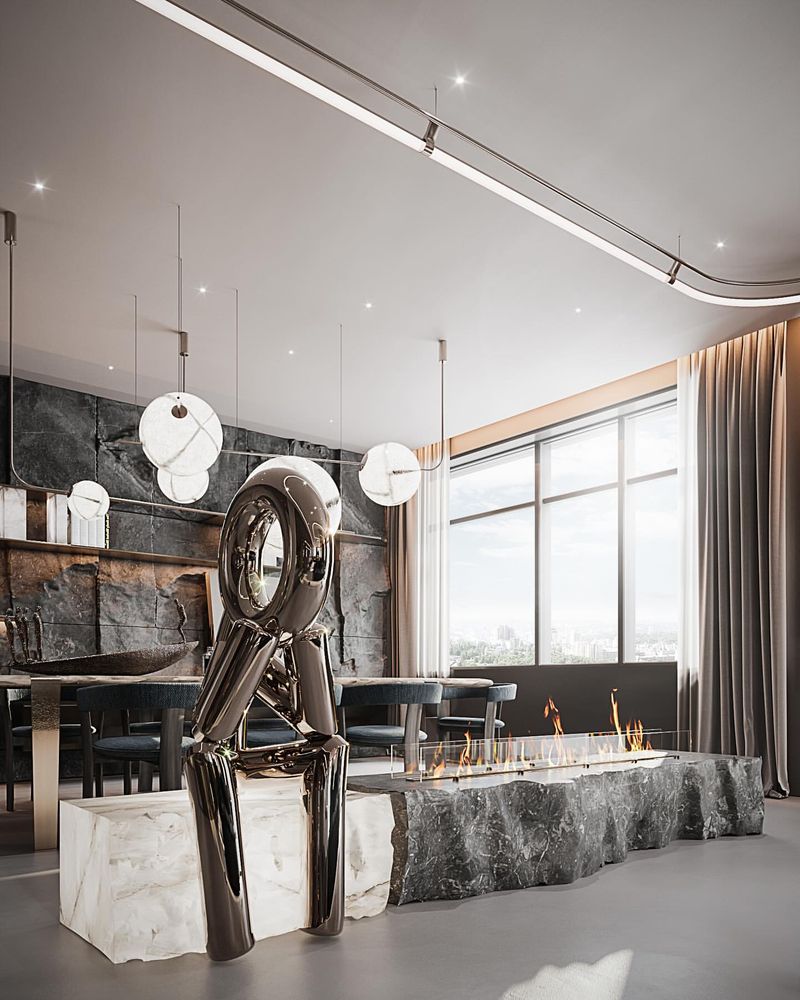
Industrial artwork can elevate a space by adding visual interest and depth. It’s about choosing pieces that reflect the style’s raw and edgy essence, like abstract or metallic art.
I often suggest incorporating large canvases or sculptures that resonate with the industrial theme, making them focal points. These artworks not only enhance the aesthetic but also tell a story, making your space uniquely yours. Art in industrial design is about expression and embracing the unconventional.
12. Metal Fixtures
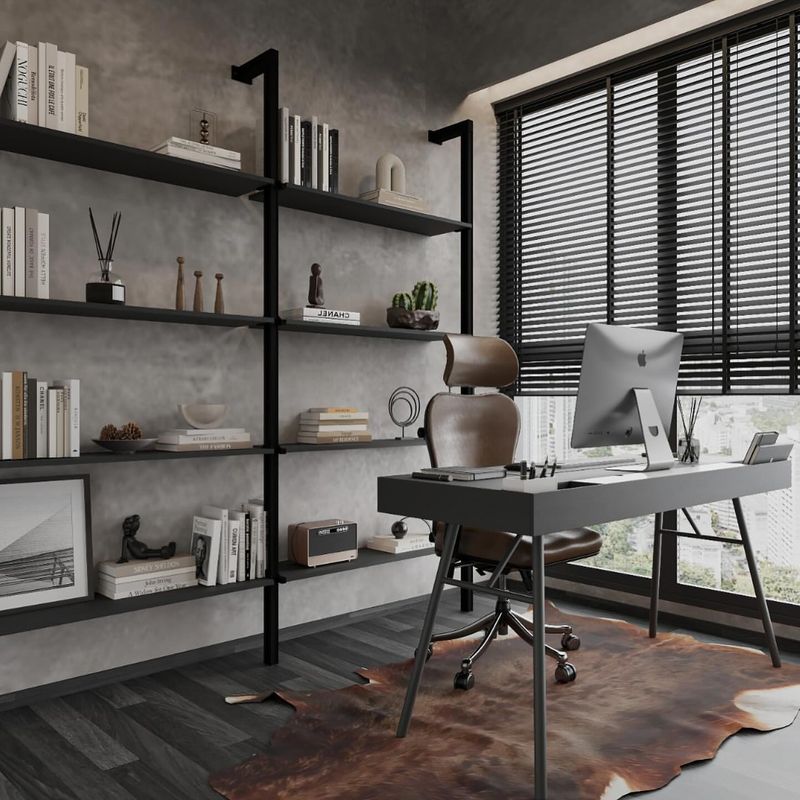
Metal fixtures are the jewelry of industrial design, adding a touch of shine and sophistication. From faucets to handles, these elements are all about form meeting function.
I believe in opting for metals like steel, iron, or brass, which align with the industrial palette. They offer durability and style, tying together different aspects of the design. These fixtures bring a cohesive look, enhancing the room’s overall appeal with their polished finishes and timeless elegance.
13. Reclaimed Materials
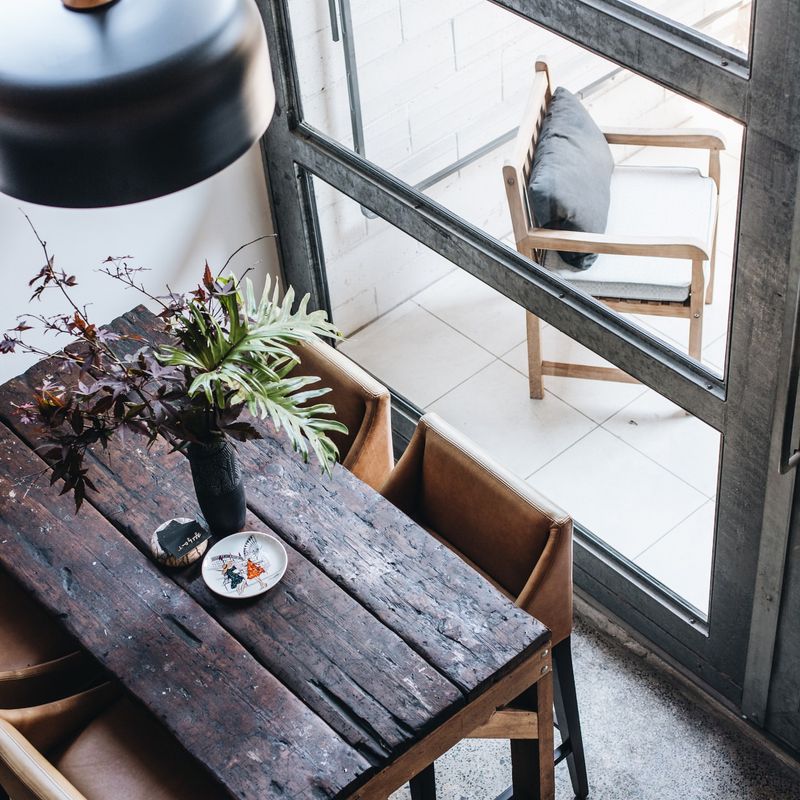
Reclaimed materials offer a sustainable edge to industrial design, celebrating history and reducing waste. Whether it’s wood, metal, or glass, these materials bring a unique character.
I appreciate how they introduce stories of their past lives, adding depth and authenticity to a space. Using reclaimed materials is not only environmentally friendly but also a creative process, turning old into new. It adds a distinctive touch to interiors, making each piece truly one-of-a-kind.
14. Neutral Color Palette
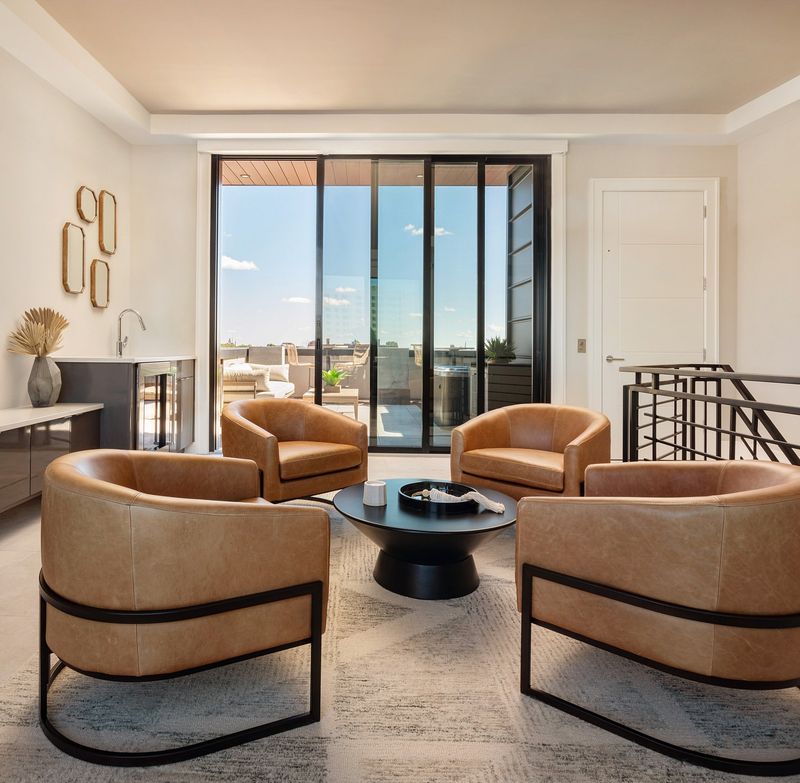
A neutral color palette is the backbone of industrial design, providing a calming backdrop for bolder elements. Shades like gray, black, and white create a sophisticated and timeless look.
I find that these colors allow for versatility in incorporating different textures and materials. They act as a blank canvas for your creativity, enabling other design elements to shine. Embracing neutrals means focusing on simplicity, elegance, and letting your space speak for itself.
15. Functional Decor
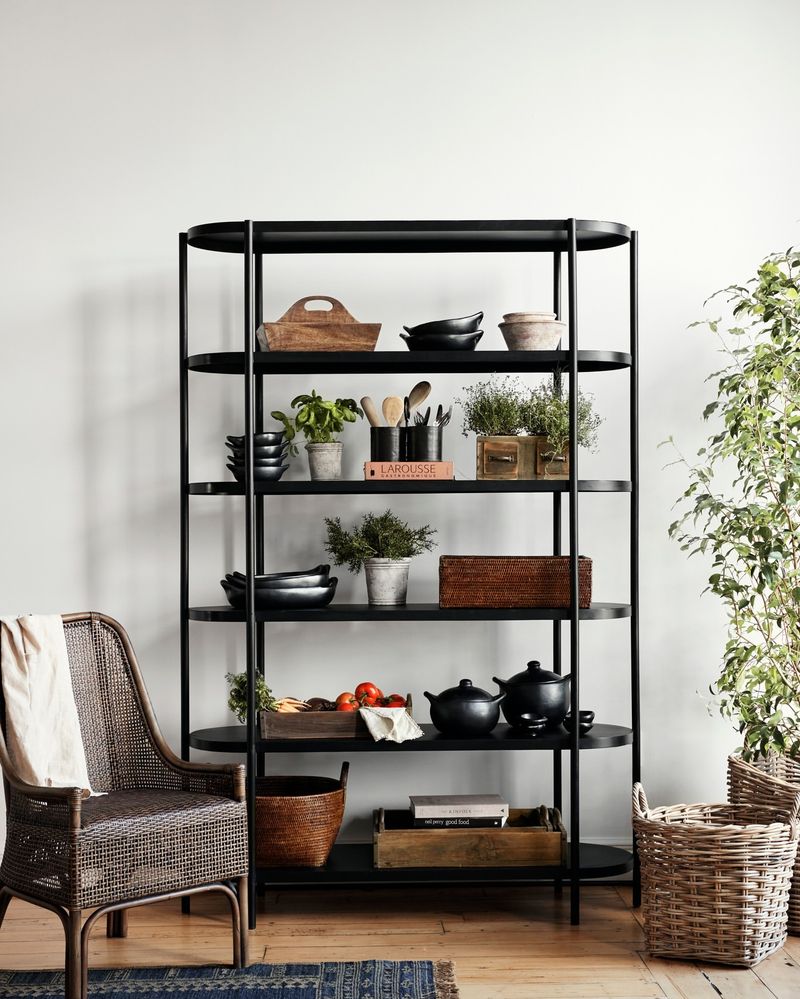
Functional decor is a hallmark of industrial design, blending utility with aesthetics. It’s about selecting pieces that serve a purpose while enhancing the overall look.
I often recommend multipurpose furniture and storage solutions that align with the industrial theme. This approach ensures efficiency and style, making the most of every inch. Functional decor means living smart, with each piece adding value and contributing to a cohesive, practical environment.
16. Industrial Textiles
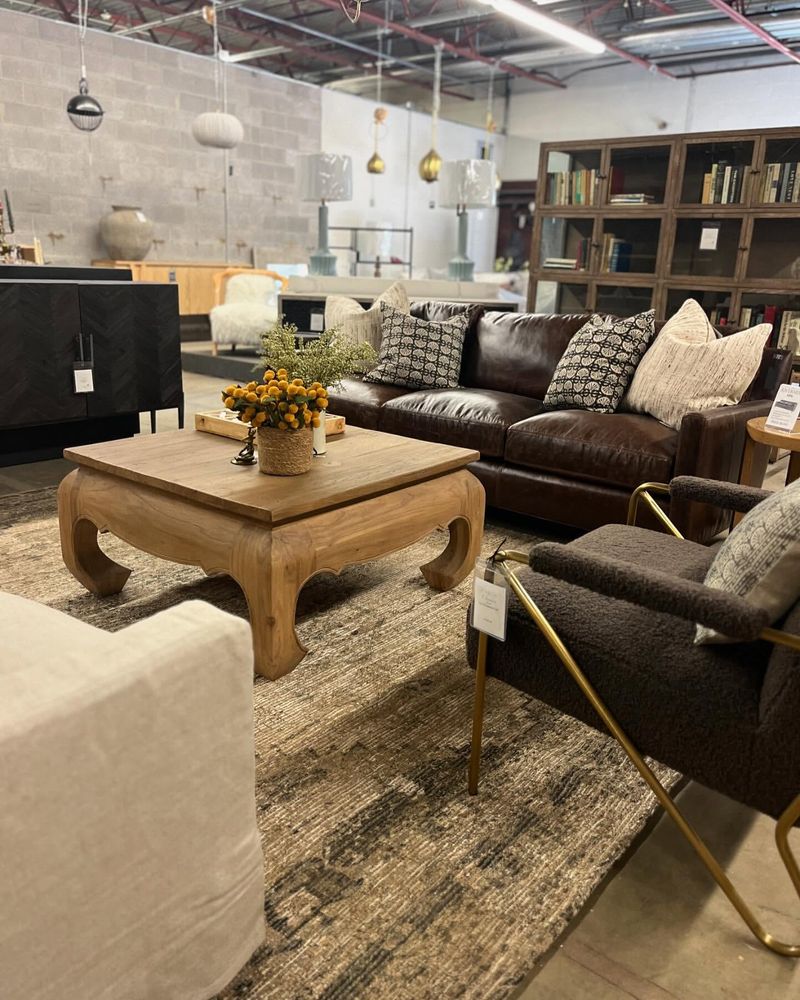
Industrial textiles add softness and contrast, complementing the harder surfaces of the design. Think heavy linen, wool, or leather for their textures and durability.
I love incorporating these textiles to add warmth and comfort, without straying from the industrial theme. They offer a tactile experience, inviting interaction and coziness. It’s about finding the balance between the raw and the refined, creating a home that’s both stylish and inviting.
17. Open Shelving
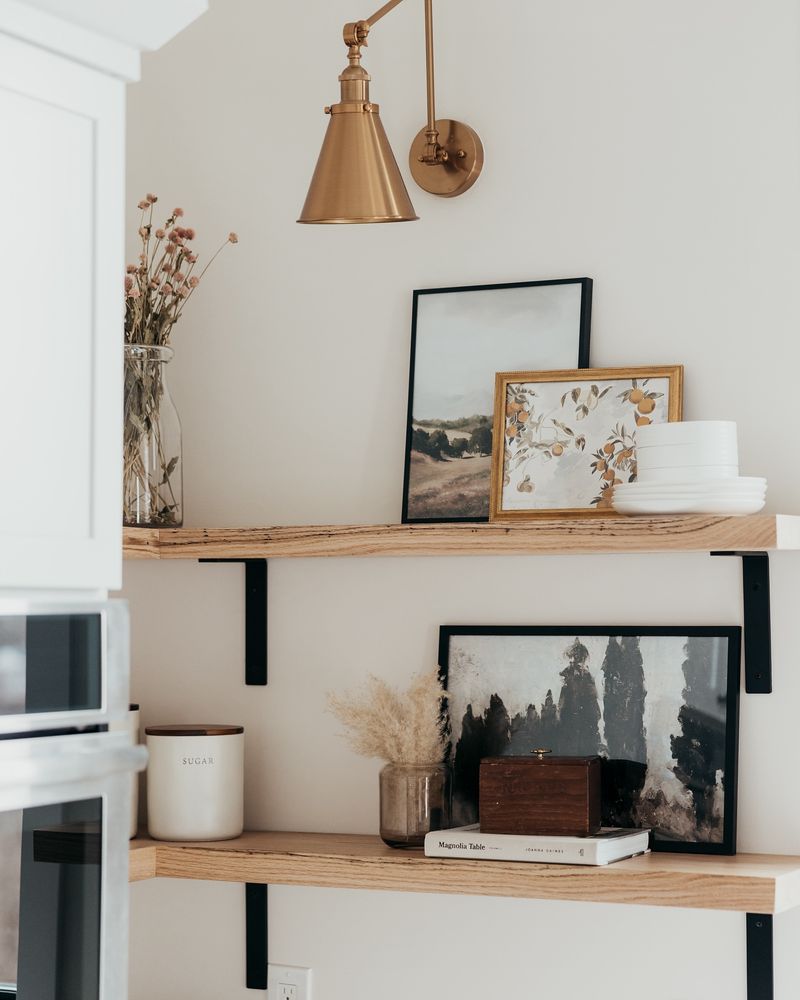
Open shelving is a practical and aesthetic choice in industrial design. It offers accessibility while showcasing your style through displayed items.
I believe that open shelves create a dynamic visual element, breaking up solid walls and adding depth. They allow for personalization, letting you curate your belongings as part of the decor. Embracing open shelving is about organization and expression, making it a versatile and engaging design feature.
18. Crittall Windows
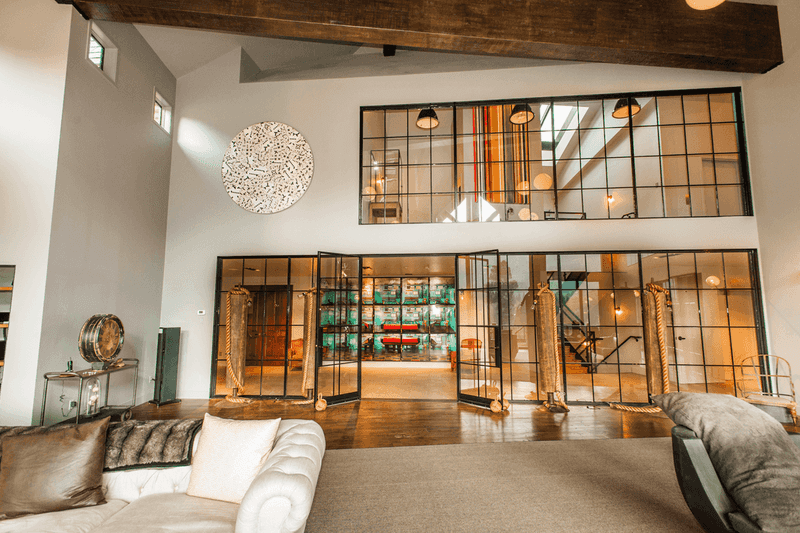
Crittall windows are iconic in industrial design, known for their sleek, metal-framed panes. They allow for maximal light entry and create a connection with the outdoors.
I often praise these windows for their ability to transform spaces, making them feel brighter and more expansive. They blend functionality with elegance, offering a modern twist on classic industrial style. Crittall windows are about framing views and enhancing the architectural beauty of a space.
19. Industrial Rugs

Industrial rugs add a layer of comfort and style, grounding spaces amidst the harder surfaces. Look for geometric patterns and earthy tones that complement the industrial palette.
I find these rugs perfect for adding warmth and texture without overwhelming the room’s design. They serve as anchors, defining areas within open spaces. Embracing industrial rugs means finding harmony between soft and hard, creating a cozy yet stylish living environment.
20. Black Accents
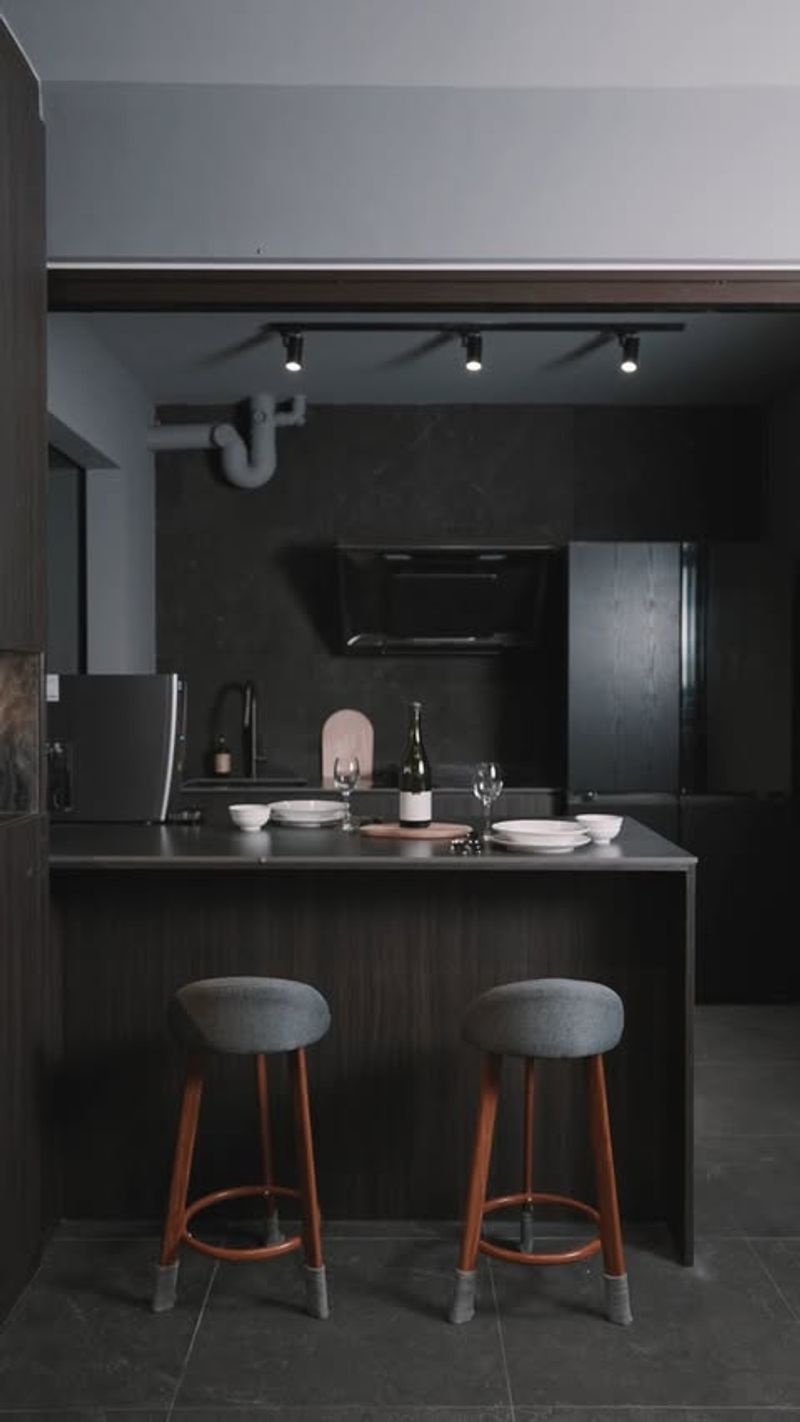
Black accents provide a striking contrast in industrial interiors, adding depth and drama. Whether it’s through furniture, fixtures, or decor, black elements enhance the design’s boldness.
I often use black to create focal points, ensuring it ties in with the overall color scheme. It’s about balance and sophistication, where black acts as a defining element. These accents bring a modern edge, making industrial spaces feel polished and cohesive.
21. Industrial Plants
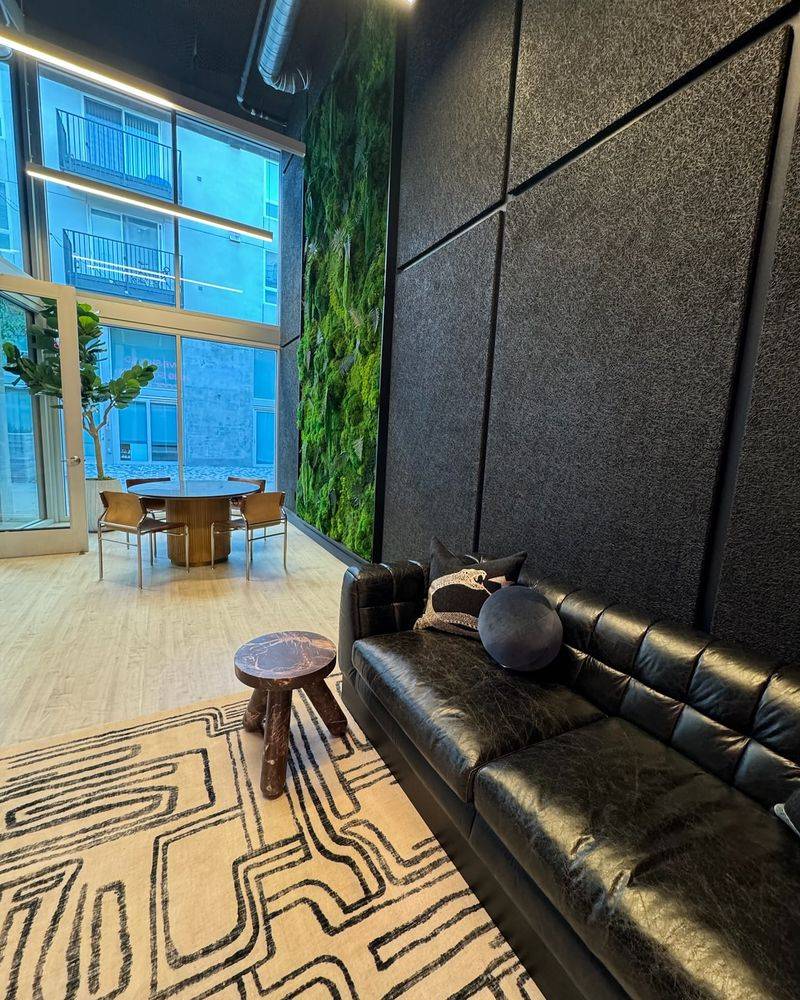
Industrial plants introduce life and vibrancy to the often stark interiors. They soften the rawness and add a refreshing, organic element.
I love incorporating plants in unique, industrial-style planters, which complement the decor beautifully. It’s about choosing greenery that thrives indoors, adding color and texture. Plants are a reminder of nature amidst urban settings, offering a breath of fresh air and enhancing well-being.
22. Tiled Backsplashes
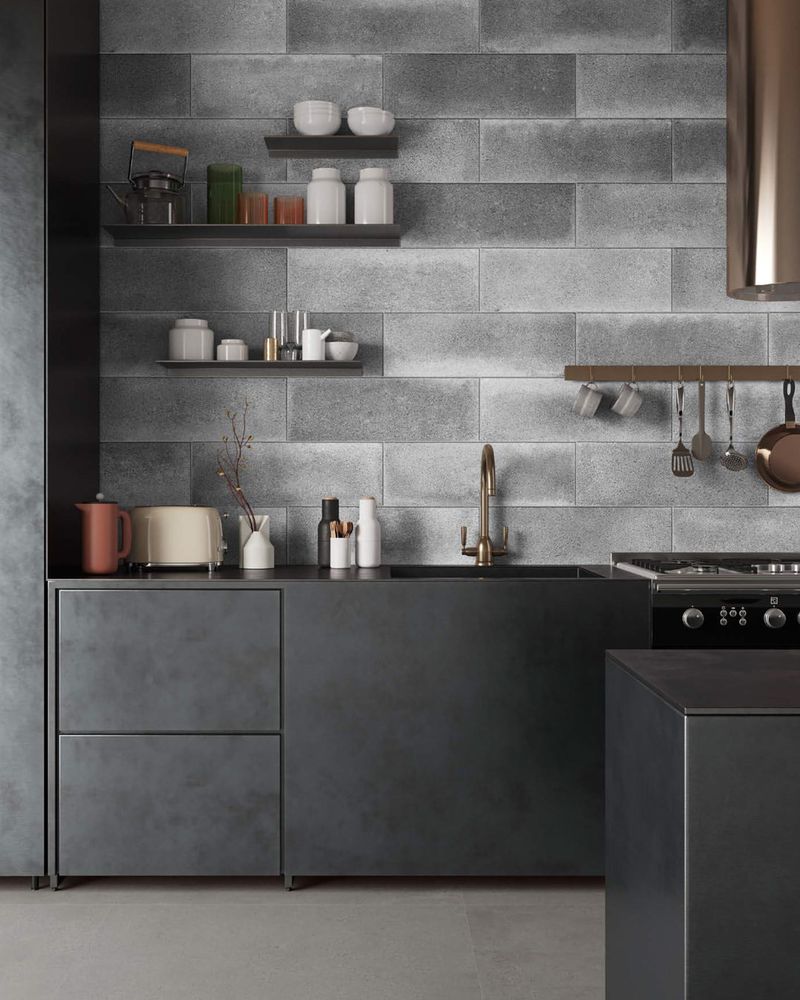
Tiled backsplashes are a practical and stylish feature in industrial design. They offer durability and ease of maintenance while adding visual interest.
I often suggest subway tiles or geometric patterns in muted tones, which align with the industrial aesthetic. These backsplashes are perfect for kitchens and bathrooms, where function meets form. It’s about creating a cohesive look, with tiles that echo the room’s style and provide a polished finish.
23. Exposed Ductwork
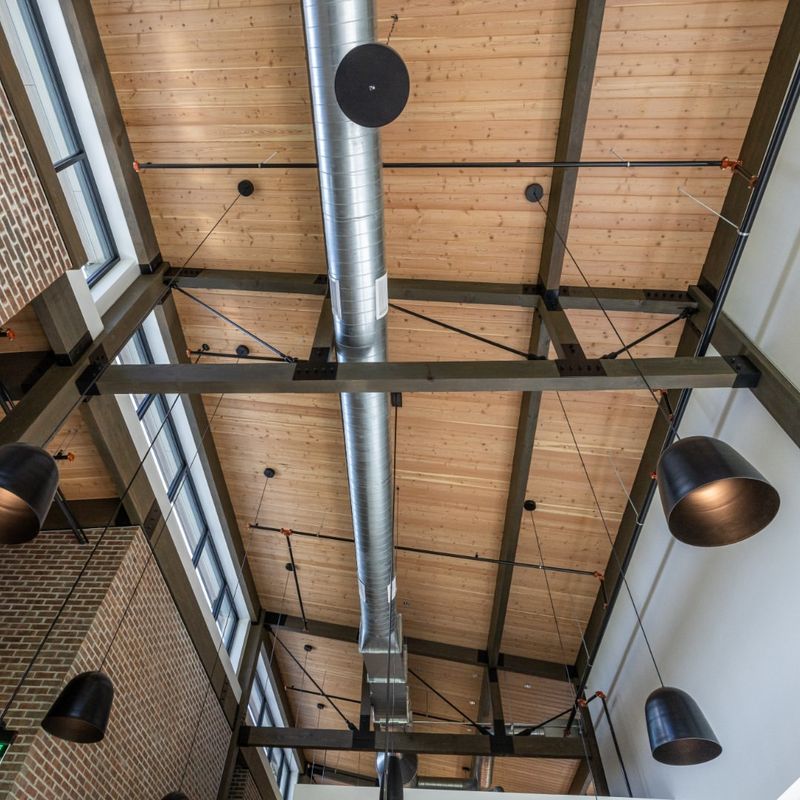
Exposed ductwork is a signature element of industrial design, celebrating the beauty of raw, functional components. It adds a sense of authenticity and architectural interest.
I believe in highlighting these elements to emphasize the design’s structural honesty. The ductwork becomes an integral part of the decor, aligning with the industrial ethos. It’s about embracing what’s typically hidden, making it a focal point and showcasing a unique aesthetic.
24. Industrial Doors
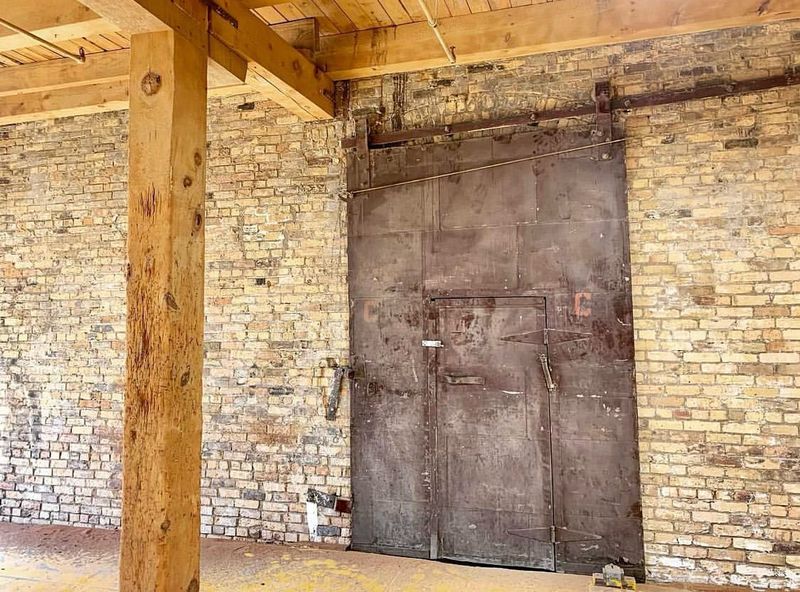
Industrial doors add character and charm, enhancing the functional beauty of a space. Whether sliding or hinged, these doors feature materials like metal and glass.
I love how they offer both privacy and openness, depending on the design. Industrial doors can transform entrances, making them inviting and stylish. It’s about integrating practicality with visual appeal, creating a seamless transition between spaces.
25. Metal Stairs
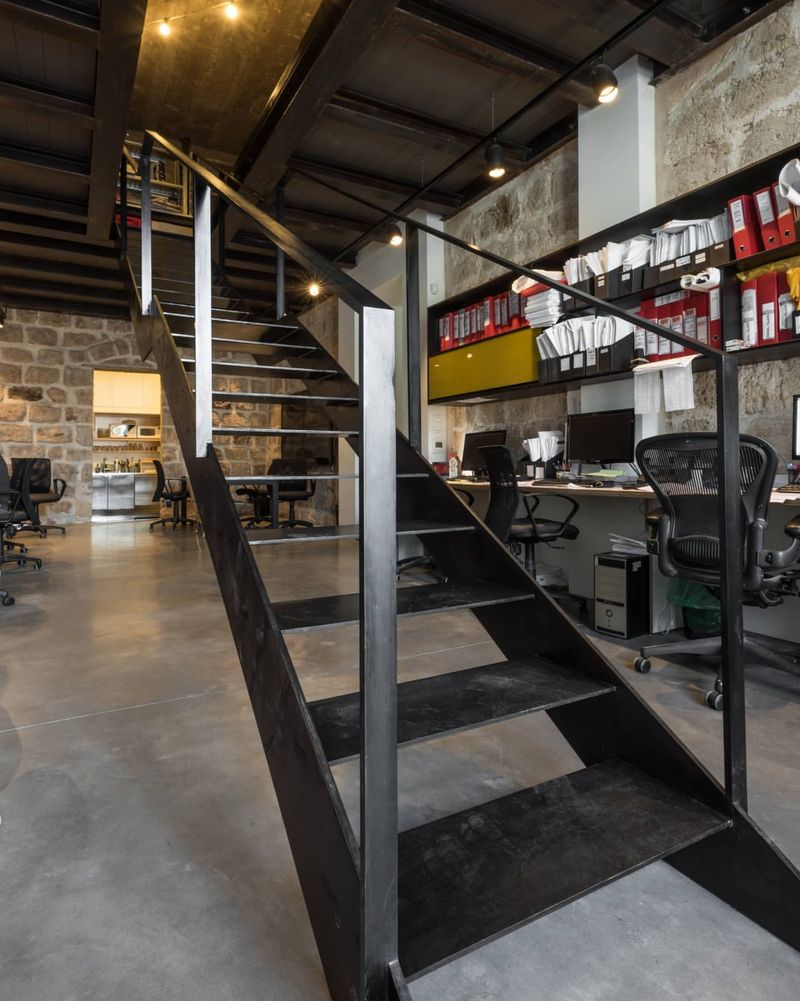
Metal stairs are a sculptural element in industrial design, merging form with function. They offer a sleek, modern aesthetic while providing durability and strength.
I often admire the way these stairs can redefine a space, acting as a bold architectural feature. Whether spiral or straight, they enhance the room’s vertical dimension. Metal stairs are about celebrating industrial materials, creating a dynamic and engaging interior.
26. Industrial Fireplaces
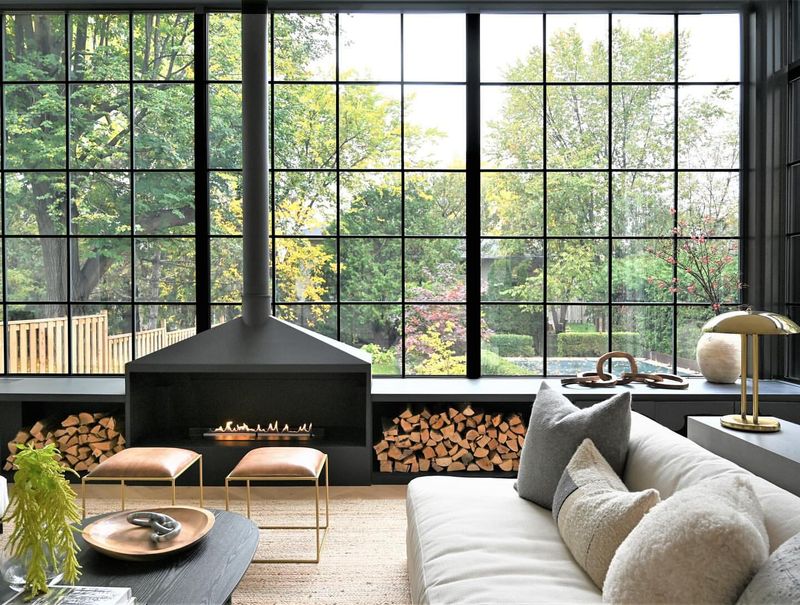
Industrial fireplaces add warmth and a focal point to interiors. Featuring materials like metal and concrete, they blend seamlessly with the design’s theme.
I find these fireplaces perfect for creating a cozy atmosphere, balancing the room’s rugged elements. It’s about finding the right design that complements the space, offering both style and functionality. Industrial fireplaces are a welcoming touch, bringing together comfort and contemporary design.
27. Raw Materials
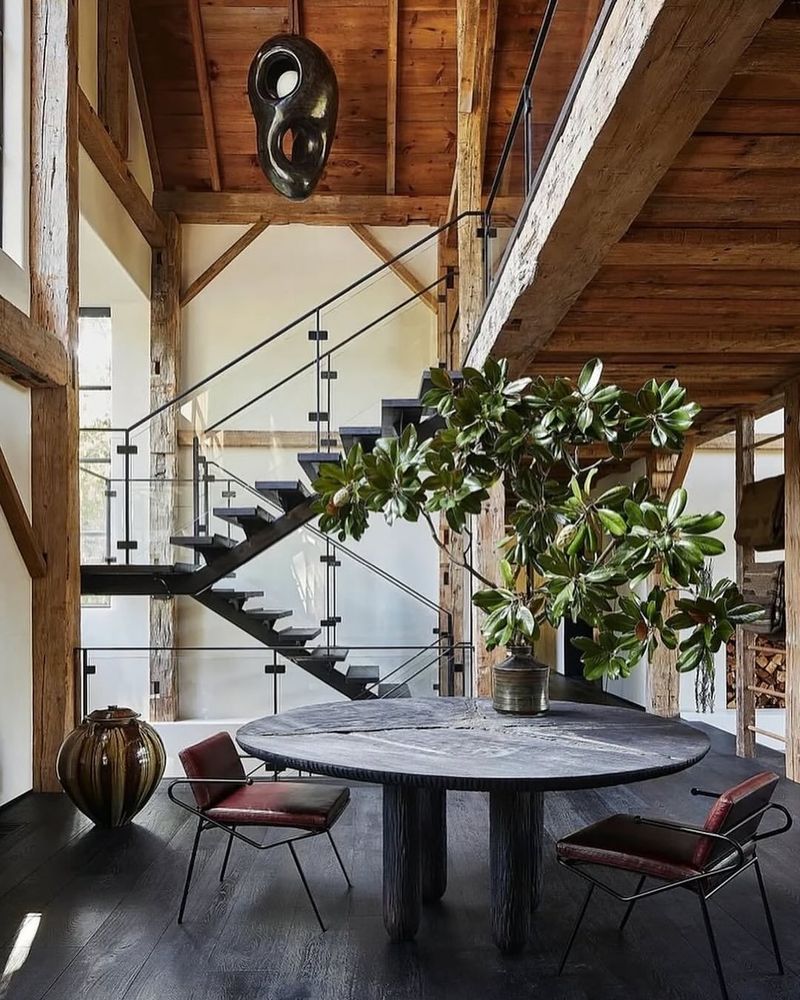
Raw materials are at the heart of industrial design, celebrating authenticity and simplicity. Concrete, metal, and wood are staples that define this aesthetic.
I love how these materials offer a tactile experience, grounding the space in reality. They provide a backdrop for creativity, allowing other elements to shine. Embracing raw materials means appreciating their natural beauty and imperfections, crafting interiors that are genuine and timeless.
28. Patina Finishes
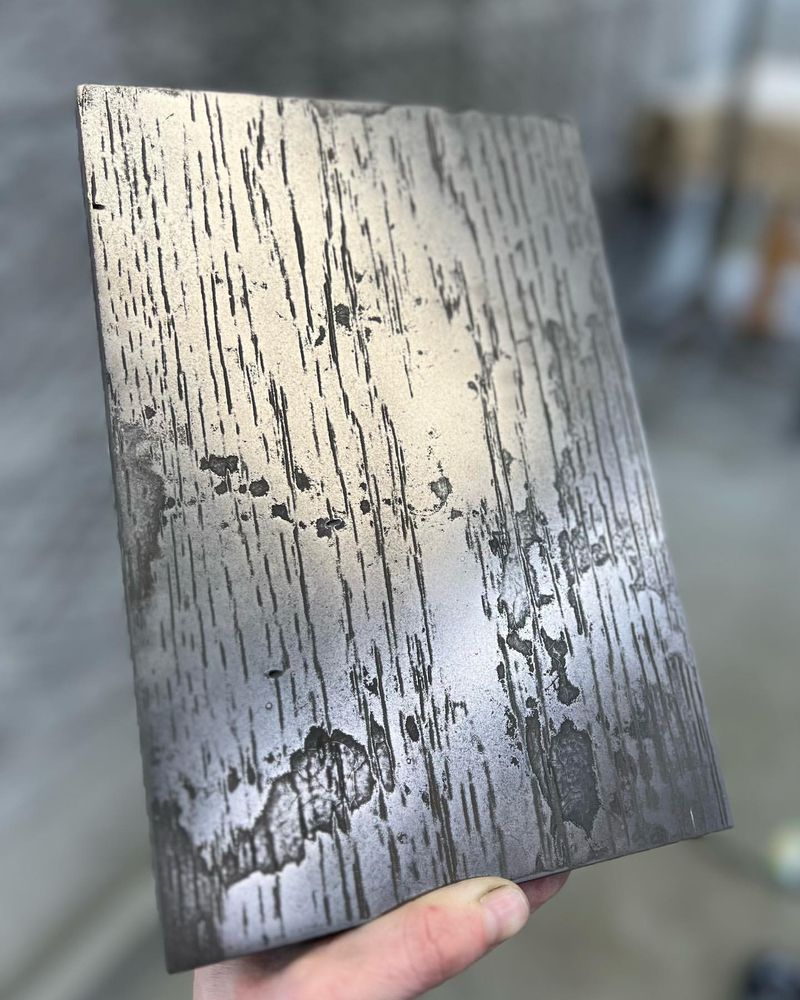
Patina finishes add depth and character, enhancing the aged look typical of industrial design. They bring a sense of history and texture to a space.
I often suggest using patina on metals or woods to evoke a vintage feel. It’s about embracing the passage of time, making surfaces more interesting. Patina finishes are a testament to the beauty of aging gracefully, creating interiors with a story and unique personality.
29. Industrial Dividers
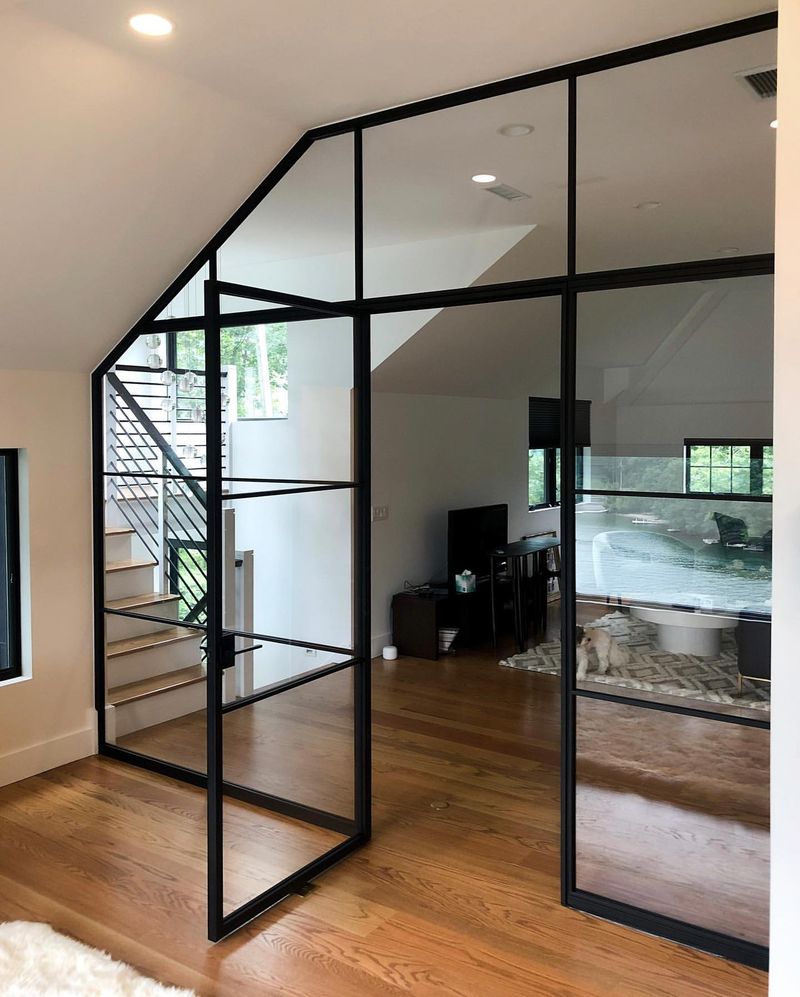
Industrial dividers offer a practical solution for open-plan spaces, providing separation without full closures. Featuring materials like metal or glass, they align with the design’s theme.
I appreciate the flexibility these dividers offer, allowing for dynamic space utilization. It’s about balancing openness with privacy, crafting areas that can adapt to different needs. Industrial dividers are a stylish way to define spaces, enhancing functionality and aesthetic appeal.
30. Riveted Details
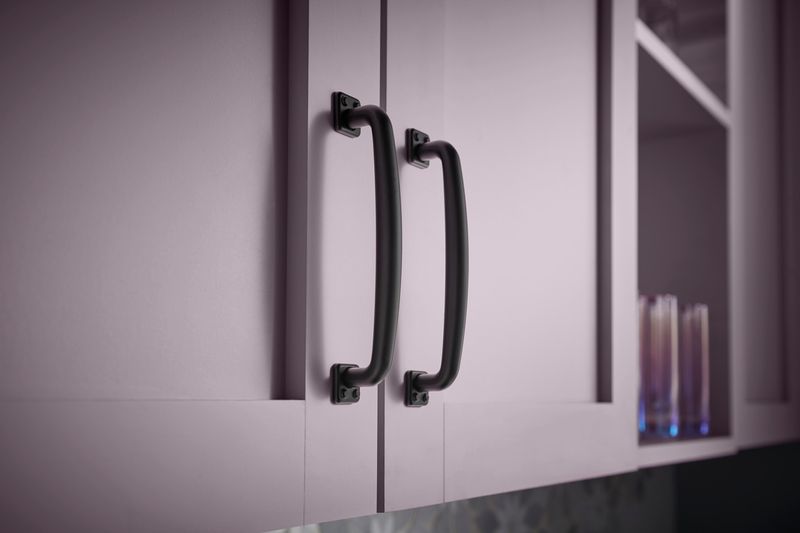
Riveted details add a touch of craftsmanship, highlighting the industrial design’s mechanical elements. They bring a subtle yet impactful decorative aspect.
I love how rivets can accentuate furniture or fixtures, adding texture and interest. It’s about celebrating the design’s structural components, making them part of the visual language. Riveted details are a nod to industrial heritage, enhancing the space with depth and authenticity.
31. High Ceilings
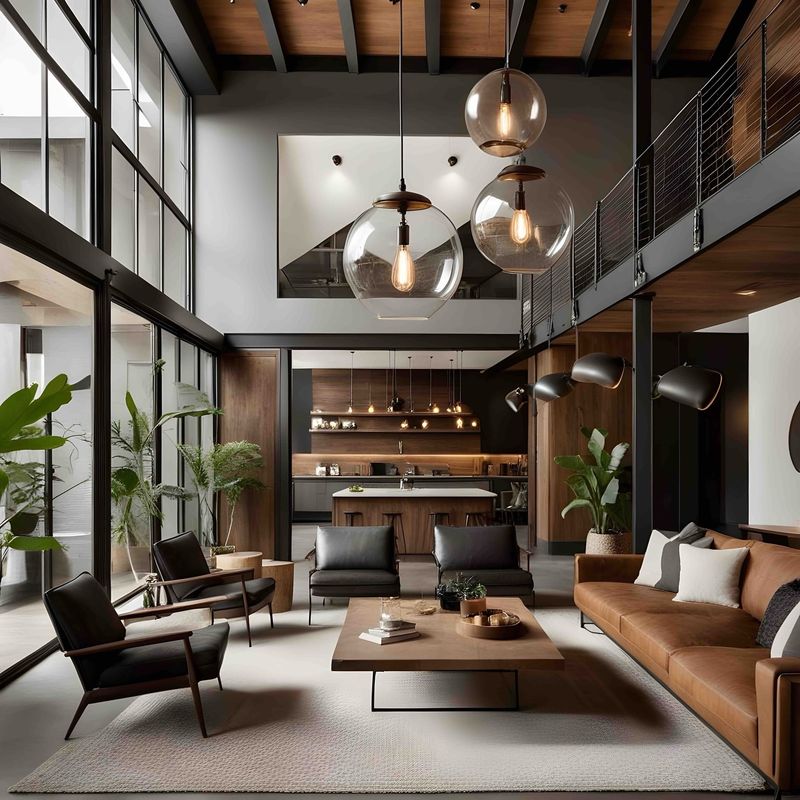
High ceilings are a defining feature of industrial design, creating an open and airy atmosphere. They enhance the room’s scale and light flow.
I admire how high ceilings allow for dramatic lighting and bold decor choices. They offer a sense of grandeur and freedom, perfect for contemporary living. Embracing high ceilings means maximizing vertical space, crafting interiors that feel expansive and inviting.
32. Industrial Kitchens
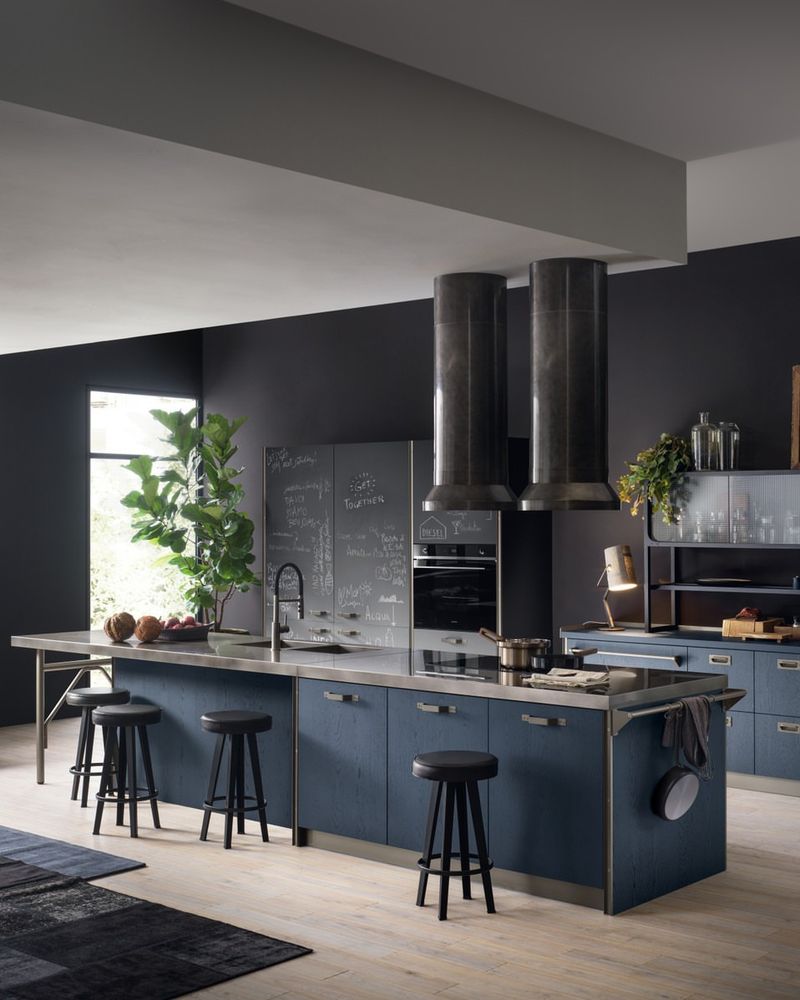
Industrial kitchens blend form with functionality, featuring sleek appliances and robust materials. They offer a professional and stylish cooking environment.
I find these kitchens perfect for those who love clean lines and efficient layouts. It’s about integrating modern technology with industrial aesthetics, creating a harmonious culinary space. Industrial kitchens are about practicality and elegance, ensuring every meal is prepared in style.
33. Mix of Textures
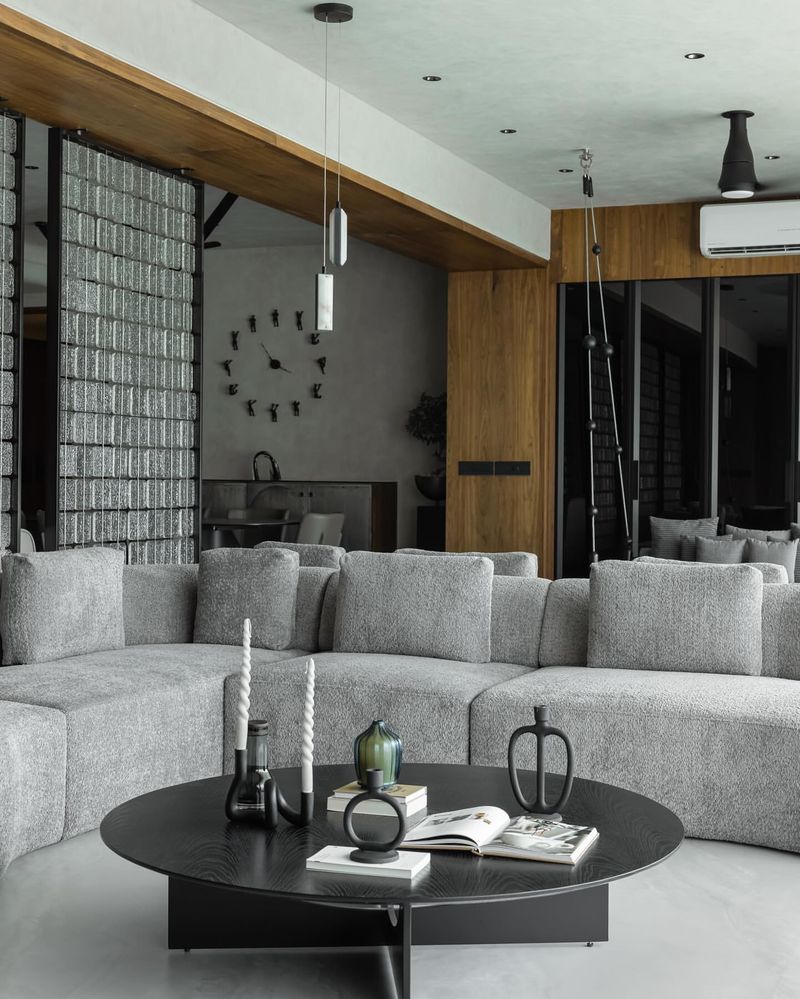
A mix of textures is vital in industrial design, adding depth and interest to a space. Combining metal, wood, and textiles enhances the visual and tactile experience.
I often recommend layering these materials to create a harmonious balance. It’s about showcasing contrasts and connections, making interiors feel dynamic and engaging. Embracing texture means inviting touch and interaction, crafting a space that’s both stylish and comfortable.
34. Industrial Furniture
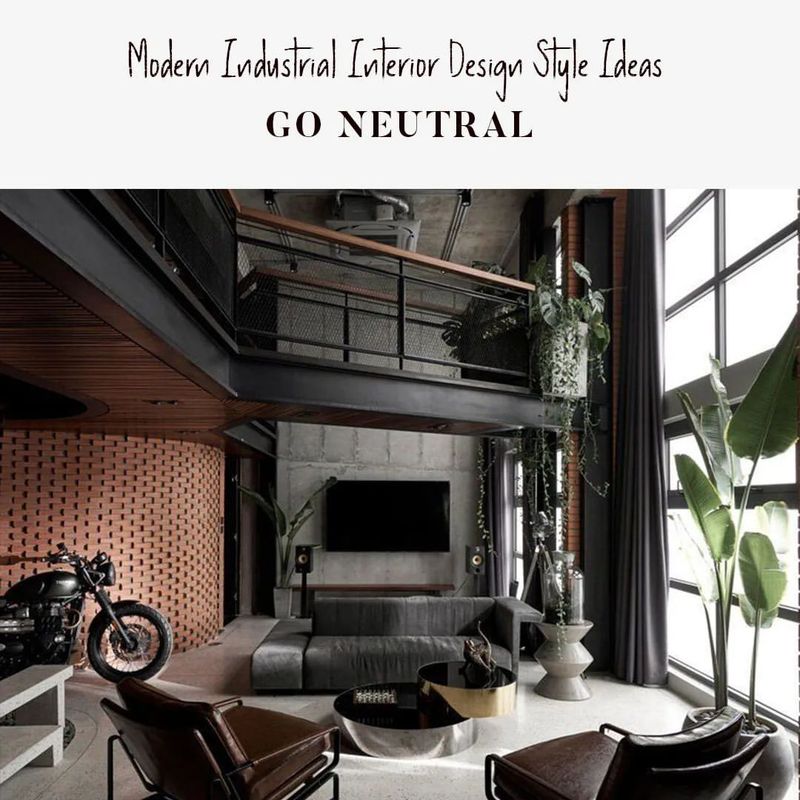
Industrial furniture combines functionality with a rugged aesthetic, typically using materials like metal and wood. It’s about creating pieces that are both durable and stylish.
I appreciate the versatility of industrial furniture, which works well in various settings. These pieces often feature clean lines and robust forms, perfect for contemporary living. Embracing industrial furniture means valuing craftsmanship and practicality, crafting spaces that are both beautiful and usable.
35. Urban Decor
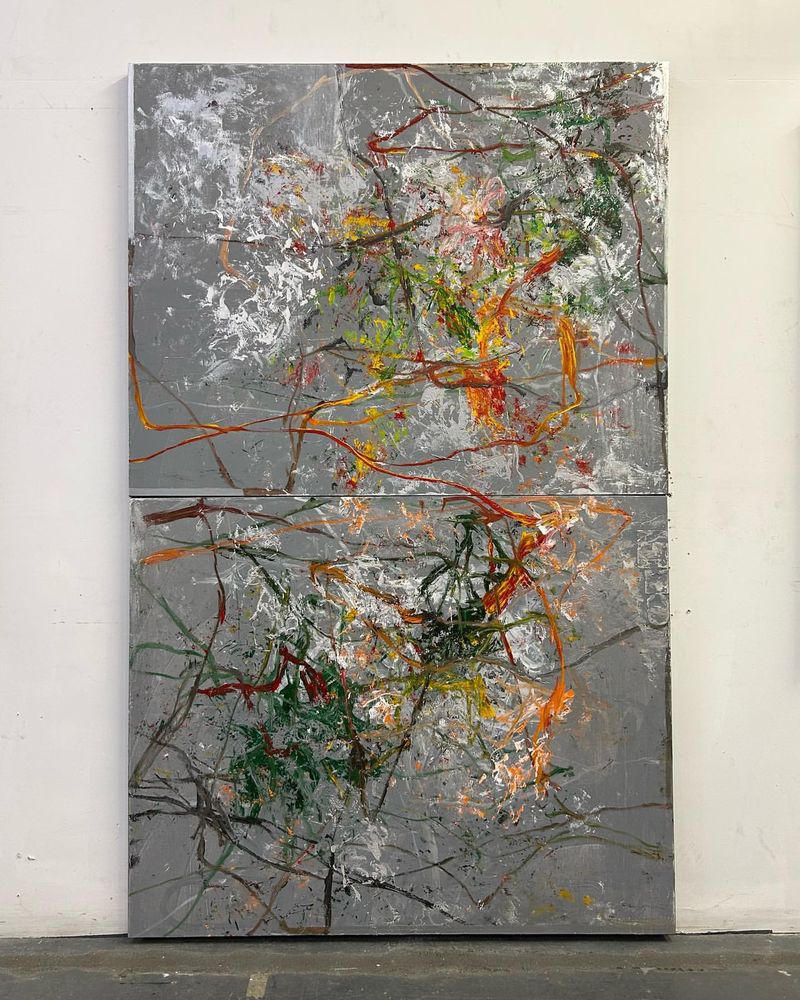
Urban decor brings the essence of city life into interiors, complementing the industrial theme. Incorporating elements like street art or graffiti adds an edgy, cultural layer.
I love the vibrancy and uniqueness urban decor offers, making spaces feel alive and personal. It’s about reflecting the energy and diversity of urban environments, creating a modern and dynamic atmosphere. Urban decor is a celebration of creativity and individuality, enhancing the industrial setting.
36. Industrial Bathrooms
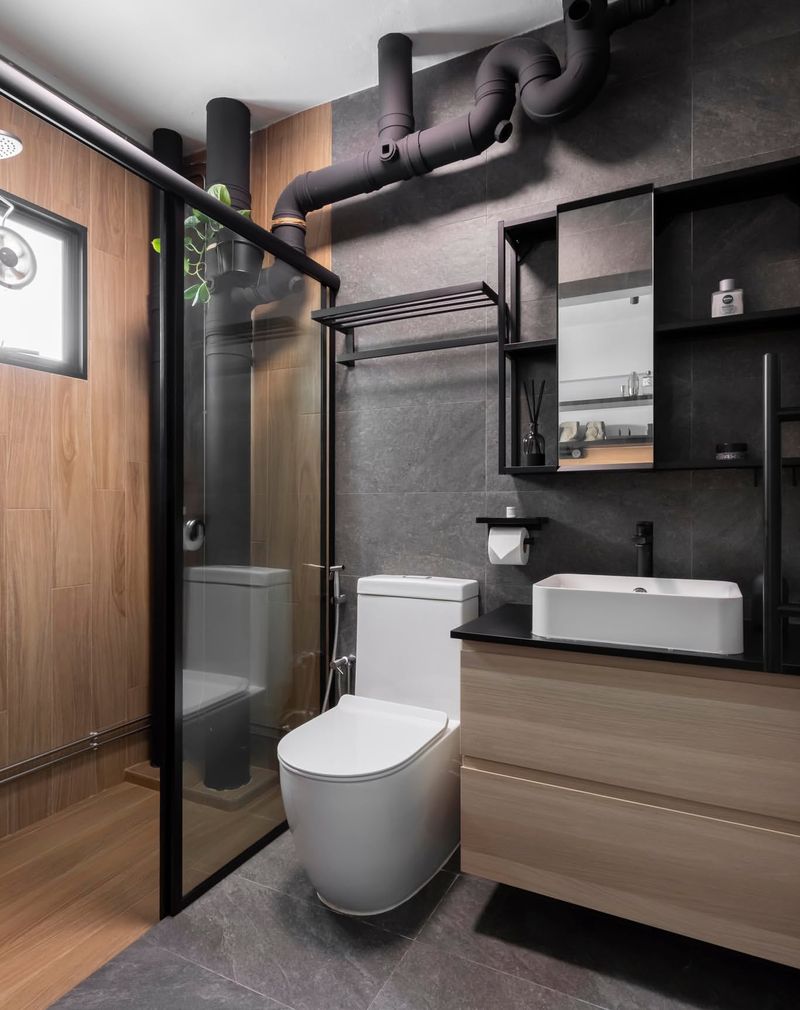
Industrial bathrooms offer a clean and functional aesthetic, focusing on materials like metal and concrete. They blend efficiency with modern style.
I find these bathrooms perfect for those who appreciate minimalist design with an edge. It’s about integrating durable materials and sleek fixtures, ensuring both longevity and appeal. Industrial bathrooms are about simplicity and elegance, crafting spaces that are both practical and visually striking.
37. Functional Lighting
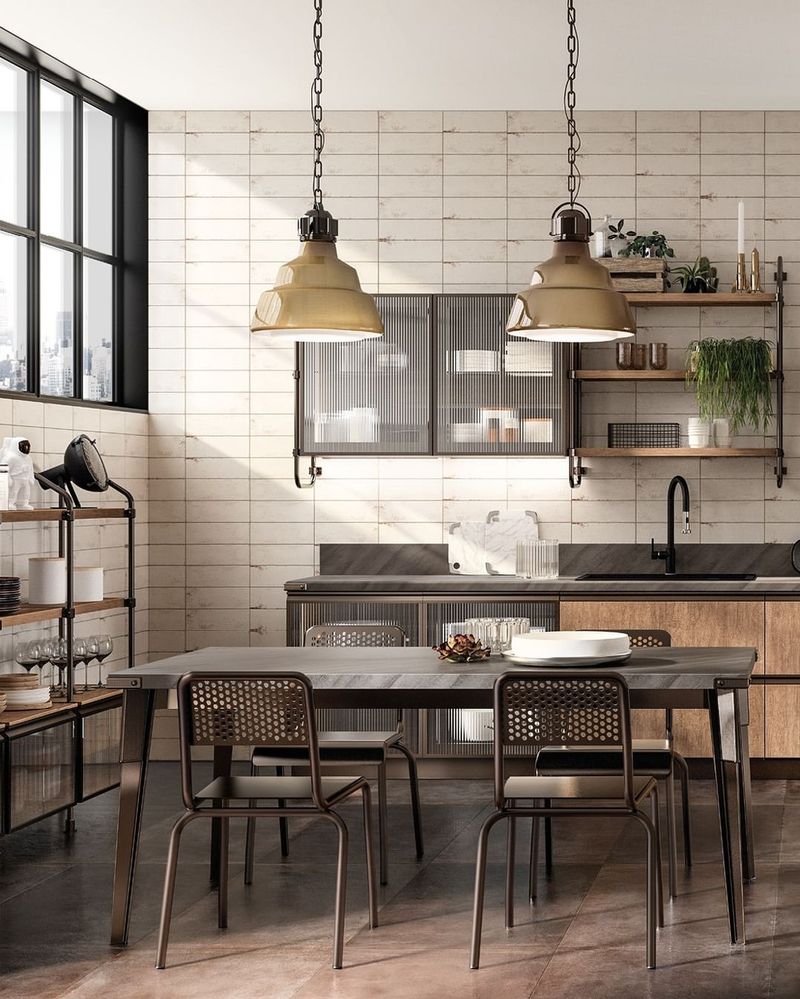
Functional lighting is essential in industrial interiors, providing both illumination and style. It’s about choosing fixtures that enhance the design while meeting practical needs.
I often suggest adjustable lamps or track lighting to create versatile light sources. These fixtures not only brighten spaces but also add an industrial flair. Functional lighting is about blending aesthetics with utility, ensuring your space is beautifully lit and thoughtfully designed.
